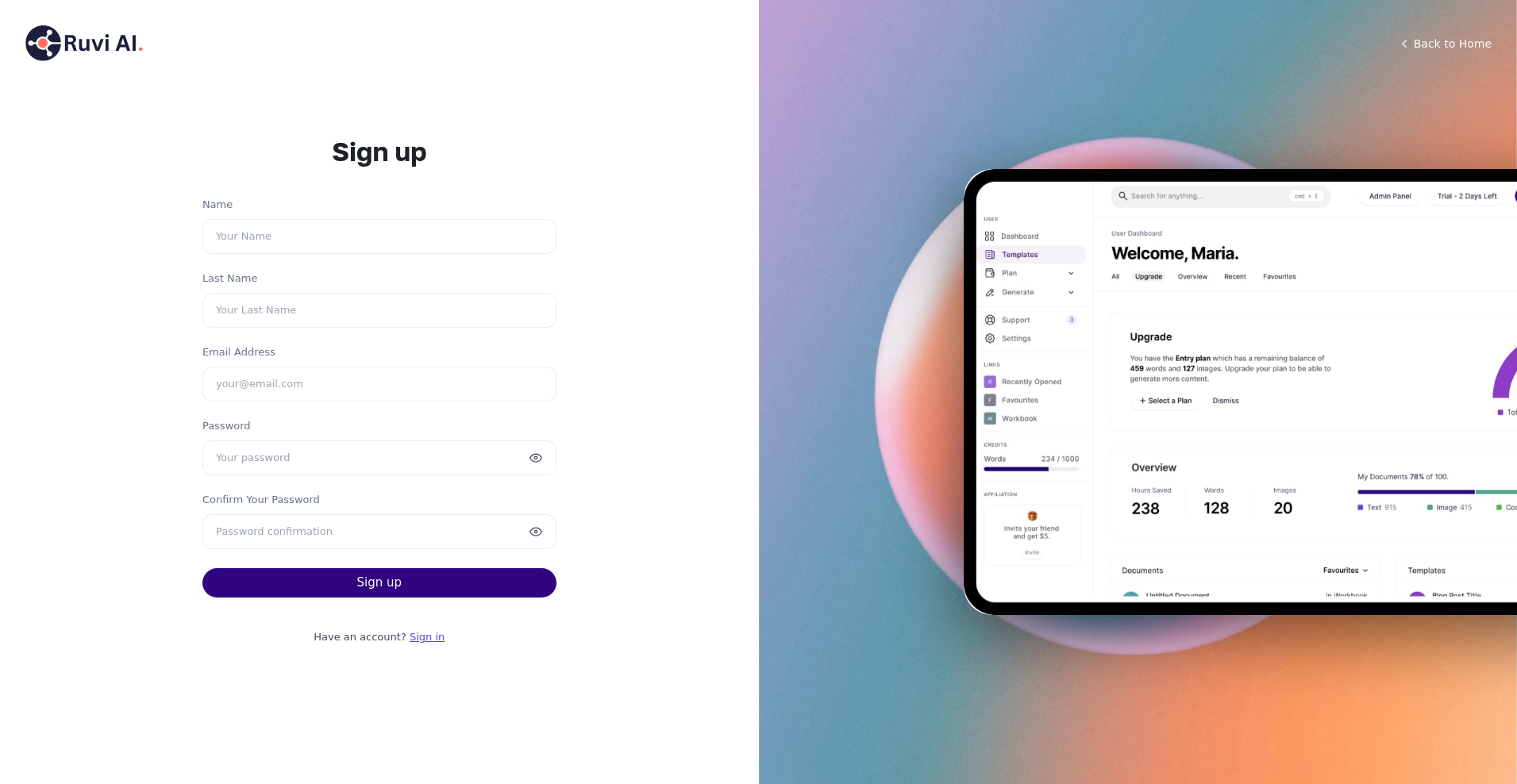Ruvi AI Review: Scam Check, Risk Analysis, and Latest Update — Is This Web3 AI Project Legit? Before You Invest

Introduction: What Is Ruvi AI and Why It Matters
Ruvi AI positions itself as "The most advanced AI SuperApp," aiming to revolutionize content creation through a decentralized, Web3-powered platform. With a comprehensive suite of AI tools that span text, image, audio, and video generation, Ruvi seeks to democratize access to cutting-edge AI technology. Built on Ethereum, the project integrates a native utility token, $RUVI, to incentivize community participation, model training, and governance. As of mid-2025, the project is actively running a presale, has launched a public beta, and promises a roadmap that includes ecosystem expansion, decentralized governance, and widespread adoption.

Team, Mission, and Goals: Transparency or Smoke and Mirrors?
The official documentation and website highlight a focus on community-driven AI development and decentralization. The project claims to have a dedicated team, with detailed developer guides and a clear vision of creating a user-powered AI ecosystem. However, there is limited public information about the founding team, developers, or advisors beyond their roles in development and partnership plans. This opacity raises red flags common in early-stage projects: without verified team backgrounds or proven industry experience, investors should remain cautious.
Legal and Privacy Framework: Terms of Service and Privacy Policy
Understanding the legal backbone of Ruvi AI is critical before investing or using the platform:
- Terms of Service: The platform emphasizes user responsibilities concerning content creation, model training, and community interactions. Users are advised to comply with community guidelines and avoid malicious activities. It also details the platform's rights to modify or terminate services without prior notice.
- Privacy Policy: Ruvi AI claims to respect user privacy, collecting minimal personal data necessary for account creation and platform engagement. Data security measures include encryption and anonymization techniques.
While the policies seem standard, their actual enforcement and data handling practices require scrutiny—especially considering the lack of KYC or AML procedures, which might hint at a semi-anonymous operational model.
Terms of Service | Privacy PolicyRoadmap and Milestones: What’s Next?
Ruvi AI’s roadmap is ambitious, with phased milestones designed to grow the ecosystem gradually:
- Q1-Q4 2024: Core AI development, alpha testing, tokenomics planning, brand development.
- Q1-Q2 2025: Public beta launch, presale deploying, initial community expansion.
- Q3-Q4 2025: Token trading, staking features, mobile app launch, governance initiation.
- 2026: Ecosystem expansion, API release for developers, creator marketplace, full DAO implementation, cross-chain integrations.
Detailed timelines are available on their official roadmap. Yet, keep in mind that delays are common, and this all hinges on successful development and community engagement.
Recent Activity and Community Engagement
Ruvi AI maintains active social channels: over 12,000 followers on Twitter (X), 4,200+ members on Telegram, and ongoing content updates. The project claims to be “the fastest-growing AI platform in 2025,” though independent verification of user base size and engagement metrics remains limited. Frequent updates, beta releases, and a live presale suggest ongoing activity, but the lack of substantial third-party reviews or audits warrants caution.
The Ecosystem: Tools, Features, and Use Cases
Ruvi AI offers a blueprint for an integrated AI platform with several notable components:
- Multi-Modal Content Generation: Generate text, images, audio, and videos within a unified environment.
- Templates and Microservices: Ready-to-use templates for marketing, blogging, business communications.
- User-Incentivized Model Training: Community feedback and micro-tasks improve AI models, rewarding contributors with $RUVI tokens.
- Marketplace and API: Future plans for a monetization hub for creators and third-party developers.
The platform’s performance depends heavily on user engagement and the quality of AI outputs, which are still evolving.
Tokenomics and Airdrop Details
The $RUVI token serves multiple utilities: governance, access to premium features, rewards, and staking rewards. The tokenomics reveal a total supply of 5 billion tokens, but the distribution breakdown shows zero allocated to presale, team, or rewards—all categories listed at 0%. This anomaly suggests placeholders or incomplete data and warrants skepticism. The ongoing presale offers tokens at $0.015, with a mid-term goal of reaching $0.020, backed by tiered bonuses for large purchases.
Participating in the presale involves connecting a wallet, choosing ETH, USDT, or USDC, and following security instructions carefully. No official airdrop has been announced as of now.
Developer Documentation and Technical Components
The project offers developer guides and API references located at https://docs.ruvi.io. These documents cover platform architecture, smart contract interactions, and SDK usage. Nevertheless, given the lack of open-source code or external audit links beyond Cyberscope, the underlying tech’s security and robustness are unclear. Their Cyberscope audit indicates a basic security review with a high security score of 89%, yet the audit assesses only token contract security, highlighting the importance of independent code audits.
Red Flags and Investment Risks
- Opaque Tokenomics: The zero percent allocations to development, marketing, or team suggest either incomplete data or a potential red flag if true. Be wary of projects with undisclosed or unverified token distribution.
- Limited Transparency: Information about core team members, advisors, or backers is sparse. Absence of KYC/AML procedures raises questions about compliance and investor security.
- Community Scores and Credibility: While active channels exist, the community score (~61%) and decentralization score (35%) imply moderate decentralization and trustworthiness. The overall fundamentals score (~53%) signals potential risks.
- Security Adequacy: Although Cyberscope reports a security score of 89% for smart contracts, on-chain audits, code repositories, and verifiable bug bounties are not evident.
- Market and Liquidity Risks: No trading volume yet, limited exchange listings, and a small initial user base can severely impact liquidity and exit options.
In essence, the project presents an exciting vision but carries considerable risks—common in early-stage, unverified projects.
Conclusion: Is Ruvi AI Legit or a Potential Scam?
Ruvi AI demonstrates a compelling combination of AI and Web3, aiming to create a community-driven content generation ecosystem. The presale, active beta, and detailed roadmap reflect genuine effort. However, significant red flags—such as lack of transparent team information, incomplete tokenomics data, and limited third-party audits—necessitate caution. Investors should conduct thorough due diligence, wait for more external security assessments, and watch for real-world adoption before committing significant funds.
In summary, Ruvi AI shows promise but remains speculative. Never invest more than you can afford to lose, especially in projects with limited transparency. Stay vigilant.

Jessica Taylor
NFT Market Data Scientist
Data scientist specializing in the NFT market. I analyze on-chain data to detect wash trading, bot activity, and other manipulations that are invisible to the naked eye.
Similar Projects
-
Useless Coin
Crypto Project Review & Scam Checker: Useless Coin - Is It a Scam?
-
eventflo
eventflo Review: Scam or Legit Crypto? Crypto Project Investigation
-
Iluminary
Comprehensive Review of Iluminary Crypto Project | Crypto Scam Checker & Project Review
-
TREND
TREND Review: Analyzing Its Security, Team, and Abandonment Risks
-
Bullie
Bullie Review: Scam or Legit Crypto? Cryptocurrency Scam Check